Hemsby Road, Martham – Windmills
With thanks to Paul Hooper and Jonathan Neville for their help with some of the following information. Also see Jonathan’s excellent website at http://www.norfolkmills.co.uk/
There were two windmills at the top of Hemsby Road on the edge of the village as shown on the map below. (At the time the map was drawn Hemsby Road was called Market Road).
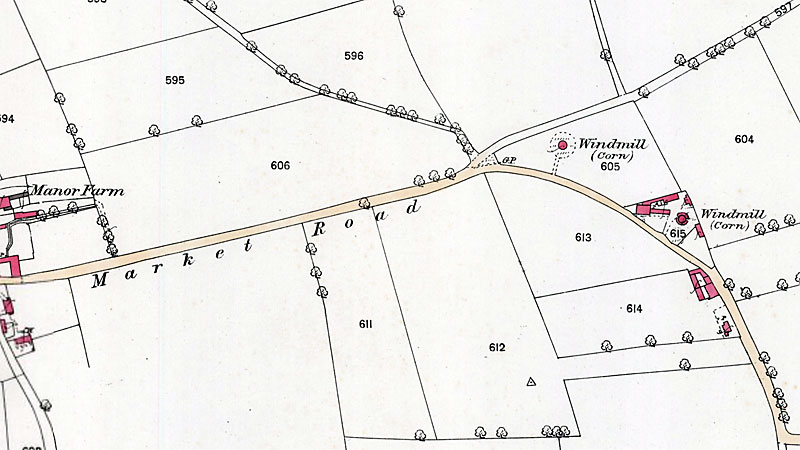
Post Mill, Market Road, Martham
Very little is known about the post mill that stood on plot number 605 shown on the above map. Recently however, and by complete chance, I came across the Will of Robert Lacey(1) of Martham who owned the mill before he died. He left the mill to his nephew Robert Rising(2). Robert was the son of John Rising(6) & Elizabeth, nee Lacey(4). The mill was freehold and Robert(1) left it plus some adjoining land, a house and barn to his nephew. The house was occupied by a widow named Mrs Bland and it stood on the small enclosure of land shown on the map surrounding the mill.
A number of additional facts have emerged flowing from Robert Lacey’s Will and it may be useful to use the section of their family tree shown below to follow subsequent events:-

- = Robert Lacey 1664-1737 was the brother of Elizabeth Lacey (4). He was also the grand uncle of Thomas Rising 1742-1794.
- = Robert Rising (1704-1760) was the son of John Rising(6) & Elizabeth Lacey(4). He was the nephew of Robert Lacey(1). He married Mary Watson in 1735. She was born in 1713.
- = Thomas Rising 1742-1794 was the grand nephew of Robert Lacey(1) 1664-1737.
- = Elizabeth Rising, nee Lacey, 1674-1714 was the sister of Robert Lacey(1).
- = Engle Knights, was born in about 1718, and was Lord of the Manor of East Somerton. He was not related to any of the others in this tree.
- = John Rising born c1673 was the grandfather of Thomas Rising 1742-1794 (3).
On 9th May 1747 Robert Rising(2) borrowed £125 by way of a mortgage given to him by William Cole, or Coles, with the post mill as security. Little is known about William Cole(s) other than that he was a small landowner and investor at Martham in the mid 18th century. He died in about 1756 and on 18th December that year his Executors settled his estate by closing the mortgage and a new loan was provided by John Barber under which Robert Rising borrowed the money for the remainder of what was recorded as being a 500 year tenure. This seems to be a remarkably long period and I wonder that anyone thought a mill would be in use that long.
Robert Rising died in 1760 and his Will was probated on 12th April that year. He left all his estate including the post mill to his wife Mary, nee Watson. She was from the Watson family that lived at Mustard Hyrn, Cess. Mary kept the post mill for ten years during which time she presumably let it to tenant millers but on 31st March 1770 she sold it to Engle Knights Esq. of East Somerton. He was a substantial landowner and lived at East Somerton Hall that today is called Burnley Hall. Anthony Taylor became the tenant of the post mill after Engle Knights purchased it. Engle kept it for about twelve years.
On 5th July 1782 Engle Knights sold the mill to Thomas Rising (1742-1794) for £290 which included a millhouse and the surrounding land of about one rood (a rood is an area of land equal to about a quarter of an acre). So, ownership had come full circle to a degree because Thomas Rising was the great nephew of Robert Lacey.
Who owned the mill after Thomas is unknown but an Isaac Saul and George Barnes are recorded as being millers there from about 1786-89 and it was in 1789 that it was damaged beyond repair in a fire. Mills were very vulnerable to fire caused by flour dust exploding or high winds causing the brakes to overheat when trying to stop the sails turning excessively fast. Either of these may have caused the fire.
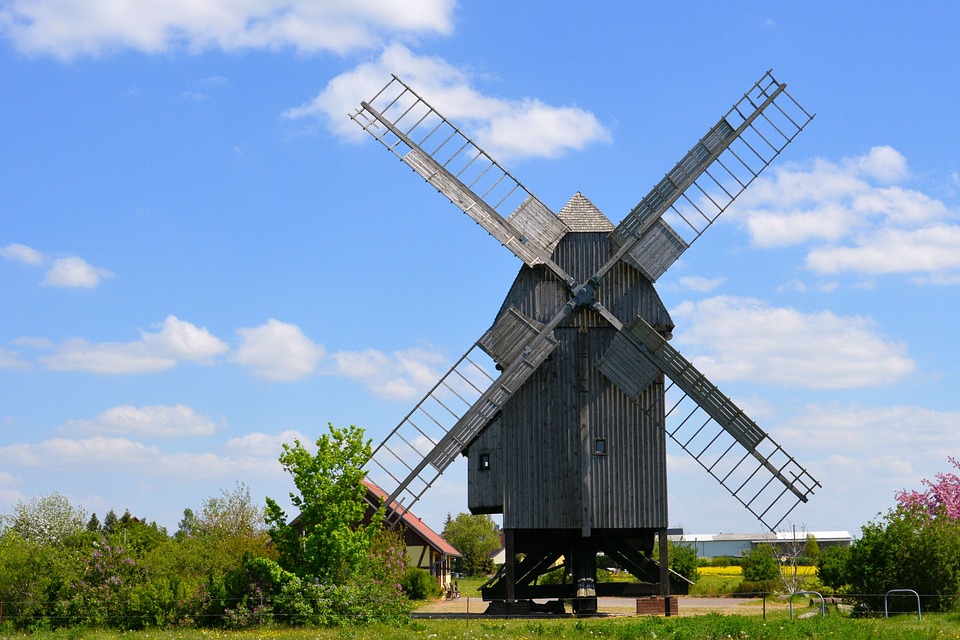
Tower Corn Mill, Market Road (now Hemsby Road)
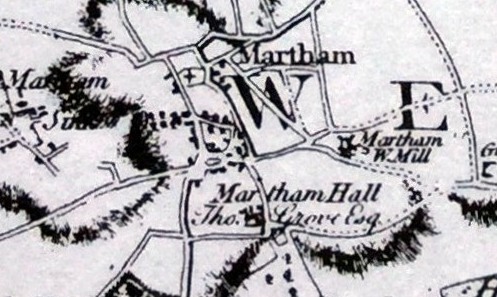
Whilst the post mill lay derelict a new mill was built a few hundred yards away to the south east and this is shown on Fadens map of 1797. It is the only one illustrated so the old post mill does not seem to have been replaced at this stage. The second mill was a corn tower mill. It was a four-storey black tarred brick building originally with two pairs of mill stones but a third pair were added later plus a steam engine to drive them. The sails powered a flour mill and a smut machine (which is a machine that removes the black spot fungus that can grow on grain if it gets damp).
William Wells Snr. was the miller at the tower mill. He married Sarah Harrison in January 1804 and they had a son named William Harrison Wells who was baptised at St Mary’s, Martham parish church, on 29th September 1805 and later in life he would go on to be a prolific mill owner but he learnt his trade at his father’s knee here in Martham.
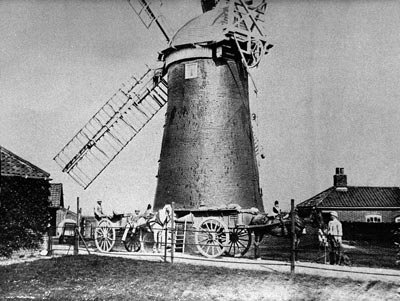
On 1st June 1811, the following advert was placed in the Norfolk Chronicle that shows the miller was Mr W Wells. This would have been William Wells Snr.
“A steady active single man who understands working a tower mill and can read and write may hear of a place immediately by applying to Mr W Wells of Martham near Yarmouth, Norfolk.”
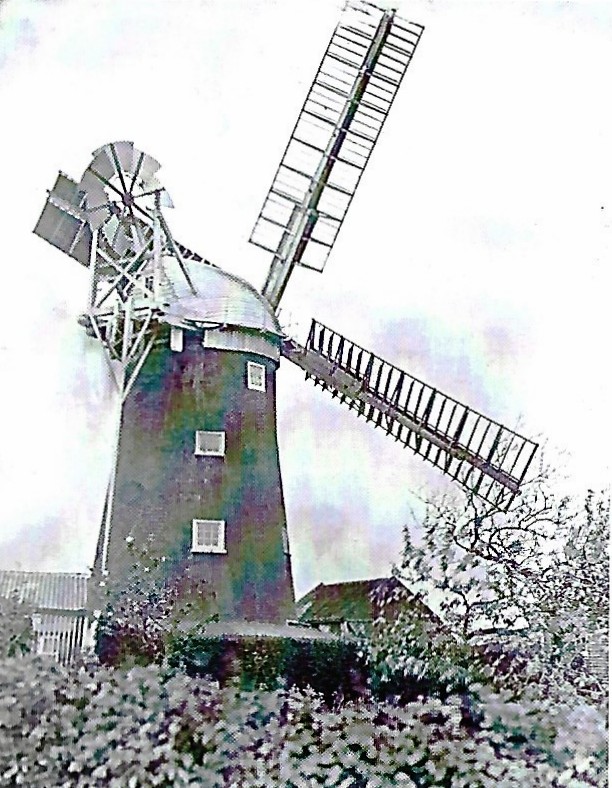
1812 Inclosure Award
At first glance there does not appear to be a mill recorded in the Martham 1812 Inclosure Award but digging a little deeper tells a different story. William Wells (Snr.) made a late claim that regular lists seem to have missed. This may be the reason why the final Award Map also has a blank plot number against not only the plot where the tower mill was but also the plot that had the earlier post mill on it. The Commissioners responsible for managing the Inclosure Award process drew up a number of preliminary maps and one pre Inclosure Award map dated 1810 does show a mill at the plot associated with the tower mill as plot No.107. A copy of both maps are shown below for comparison. (Also note that a James Bane owned the adjacent land where the former post mill was and we will bump into him again later).
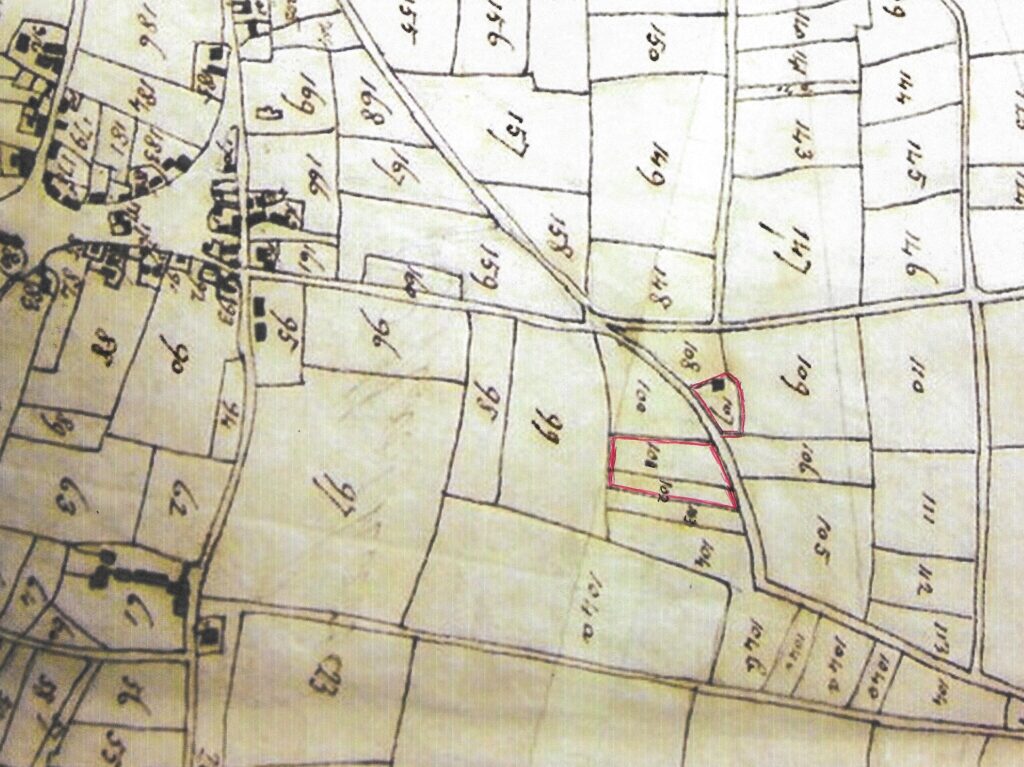
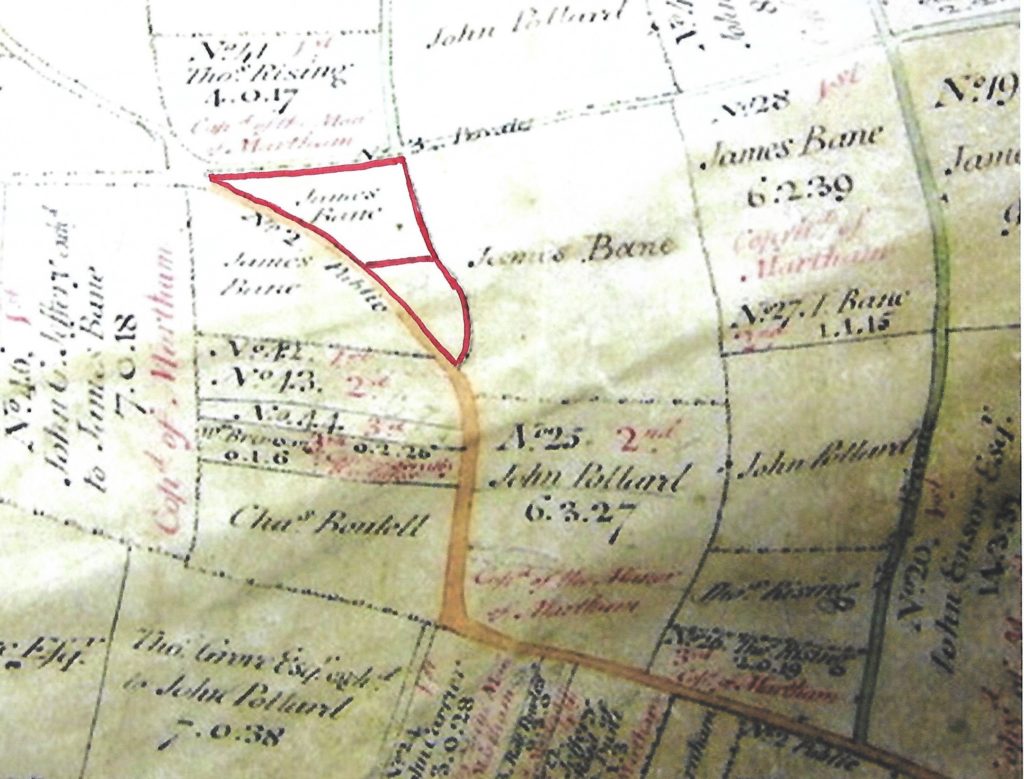
Millers did not always have a good reputation. Despite being important to the local community they were often unpopular and considered to be cantankerous, mean-spirited, and sometimes guilty of cheating. This view can probably be attributed to Geoffrey Chaucer who from the early 14th century labelled millers as guilty of sharp practice and dishonesty. A steady stream of millers were accused of adulterating flour with alum throughout the 19th century. Similar tales must have circulated in and around Martham and rumours spread to such an extent that William decided to published the following proclaiming of his innocence in the Norfolk Chronicle on 20th May 1812:
“Whereas a malicious and unfounded report has lately been circulated, injurious to the character of Mr William Wells of Martham in the County of Norfolk, Miller, stating that he has adulterated his flour and been fined by the Magistrates for doing so; but knowing that he has not been guilty of the alleged circumstances he feels himself compelled to declare publicly they are false and without any foundation whatsoever and also that he will prosecute any person or persons with utmost rigour of the law, who may vilify and defame his character in the like manner, unjustly and undeservedly.”
1830-1840
The next reference we get to a Wells being a miller at Martham is in Robert Porters odd little book called “The Strangers Guide Book for the Polite Village of Martham”. The book was published around about 1830 and mentions both Wells and Bane as being millers and includes a short verse in tribute to them:
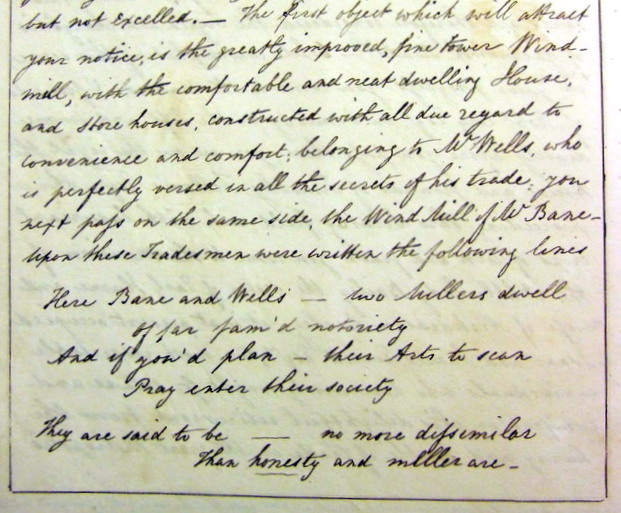
Transcription: “Here Bane and Wells – two millers dwell of far farm’d notoriety. And if you’d plan – their Arts to scan. Pray entry their society. They are said to be – no more dissimilar. Than honesty and miller are.
Two millers so two mills, the tower mill was owned by William Wells Snr, and the other – a replacement for the original post mill that had been destroyed by fire was owned by Bane. The Bane in question was James Bane the son of John Bane & Mary, nee Appleton. He was born at Happisburgh on 23rd May 1768 and married Esther England in 1790 at Acle. This branch of the Bane family were associated with Martham for several generations. James had a nephew who was also called James (1793-1861) who was married to Esther, nee Martin and he was the miller at Erpingham in 1845 before moving to Martham and becoming a farmer. Two generations later his second, great, grand nephew – James William Bane – would become well known in Martham for taking over Alcocks Cash Stores that did business out of what is today known as Norwich House.
James, of Happisburgh, died in 1834 and made a Will shortly beforehand which tells us two things. Firstly that he had let the Martham mill to William Harrison Wells who was the occupier in 1834 and secondly that he left his mill to his daughter Elizabeth (not his wife Ester). A copy of his full Will can be seen in the appendix at the foot of this page.
From this Will we can deduce that James Bane had owned the replacement post mill whilst William Wells Snr, had the tower mill. William’s son William Harrison Wells had grown up and was by then the miller at Dilham. The death of James Bane seems to have triggered a change of direction because both mills were put up for sale at the same time on 13th September 1834 with enquiries to William Snr. at Martham and William Jnr. at Dilham. The post mill was on offer as well as adjacent land. This is the advert in the Norwich Mercury of 13th September 1834.

Not only were both mills put up for sale but on 16th and 30th September 1834 two more adverts appeared offering them as available to let. It seems the Wells were testing the market! Mr William B Crowe was also in occupation according to an advert in 1834 for the sale of an engine and four mill stones and in 1836 according to White’s directory.
MARTHAM
Brick Tower Windmill
To be let and entered upon at Michaelmas next.
All that Capital Brick Tower WINDMILL situate in the parish of Martham in the county of Norfolk, with patent sails, winding tackle etc driving two pairs of stones, flour mill, jumper and smut machine with capacious roundhouse suitable for an extensive trade.
Also dwelling house, garden and all necessary stables and outbuildings.
The above is within 8 miles of Yarmouth and the navigable river passes through the village.
Enquire of Mr W. H. Wells, Dilham Mills or at his stand in the Corn Exchange in Norwich on Saturdays.
Norfolk Chronicle – 16th September 1834.
MARTHAM MILLS
Sale of five horse power steam mill, pair of our 4ft stones etc “… on the premises of Mr. W. B. Crowe at Mr Wells’ tower windmill at Martham, Norfolk (Mr Crowe being about to relinquish the occupation and leaving the trade.)”
Norfolk Chronicle – 30th September 1834.
1841 – 1843
The above adverts did not lead to a sale or new leaseholder because William Barnard Crowe was still living there according to the 1841 census. He was married to Anna, nee Brooks and they had eight children living with them in 1841.
The 1842 Martham Tithe Award lists the two mills separately but both were occupied by William Barnard Crowe who lived at the Mill House with his family. Plot 271 with the tower mill was owned by William Wells. Plot 272 with the post mill was owned by Frederick Bane, who was the nephew of James Bane (1768-1834). James had left his mill to his daughter, Elizabeth, whose situation in 1842 is unknown.
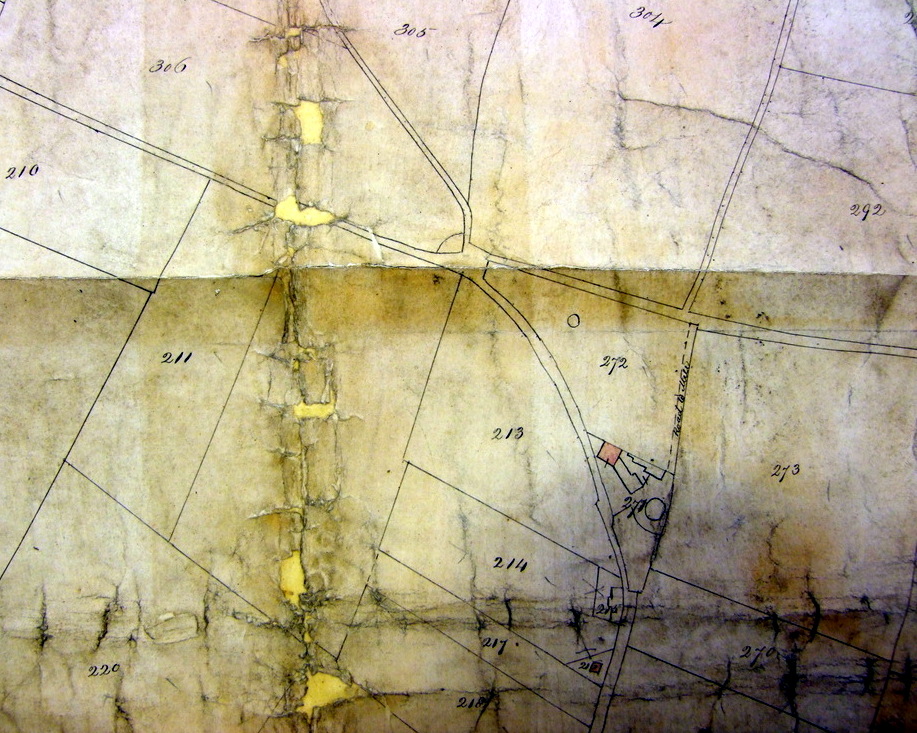
William Crowe sold his mill in October 1843 as can be seen from the notice below published in the Norfolk Mercury advertising the auction.
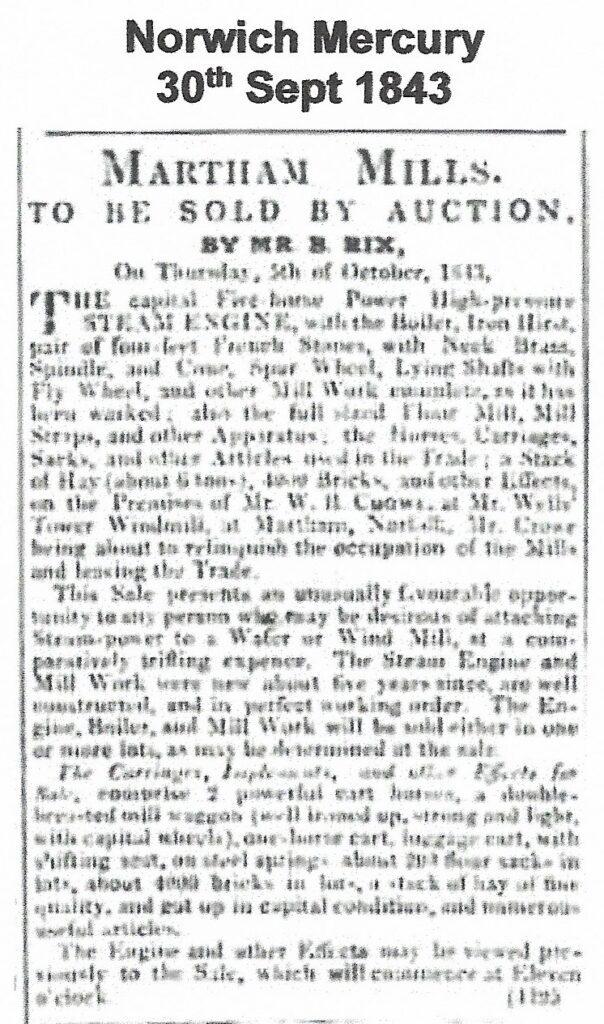
1845 – 1860
White’s directory of 1845 listed William Wells as the corn miller and William Crowe and his family had left by 1851 when he had become a farmer at Bradwell, Great Yarmouth which was where he was born in 1798.
The ownership of the tower mill was unclear at this time but had mostly likely passed into the hands of James Cooper Faulke Snr. He was listed as being the miller in Hunt’s directory of 1850. According to the 1851 census it was occupied by James who was 31 and lived there and was the miller and employed two men and an apprentice plus two servants He was single in 1851 but in 1855 he married Catherine Harvey Bane the daughter of James Bane (1793-1861) of Erpingham and grand niece of James Bane (1768-1834). Both Whites and Hunt’s Directories had James Cooper Faulke as the corn miller in 1854.
The post mill had been demolished in 1853.
1861-1885
James Faulke was still the miller living with his wife Catherine and James Jnr. The census of 1861 showed James Snr. employed three men and an apprentice one of whom was Benjamin Beck who was a journeyman miller and lived in one of the mill cottages.
On 19th December 1863 James advertised for help with the mill as follows:
Situations Vacant. To Millers. WANTED a married man without encumbrance to act as Foreman. Must be steady and obliging. Apply to J. C. Faulke, Martham Mills.
James was getting busier and busier. He still lived at The Mill House but by 1871 had become a farmer of 110 acres employing four men and a boy plus he was still the miller employing another three men and a boy.
It was hardly surprising that James was advertising for help again in 1873 when the following advert appeared in the Norfolk News:
Situations Vacant.
To Millers.
Wanted immediately, a steady industrious married man without encumbrance to work a tower mill.
Apply to J. C Faulke, Martham Mills. A cottage on the premises.
18th October 1873.
Kelly’s Directory of 1879 records James Cooper Faulke Snr. as the miller, farmer & corn merchant of Martham Mills.
One of James’ neighbours was Humphrey Dyble (1795-1883) who was a farmer who lived and farmed in Martham all his life. He kept a diary for twenty-five years from 1853 to 1878 and in that he recounts how he was a customer of James Faulke and took his corn to the mill for grinding.
James Faulke Jnr. was the miller at the time of the 1881 census employing three men. His father had moved to Manor Farm opposite Bracey’s pond on Back Lane (also shown on the map at the top of this page) but was close enough to give advice if his son needed it. James Snr. died in March 1883 having spent over 30 years as the miller and left the mill to his wife Catherine but it was run by his son. James senior is buried at St Mary’s but the exact plot is unknown.
1886 – 1890
James Jnr. may have continued at the mill until about 1886 but by then his widowed mother, Catherine, advertised for sale surplus horses and carts etc as a result of letting the mill to Mr William James Tooley. Mr Tooley did not last long as witnessed by another advert announcing his departure on 30th October 1892. Meanwhile James Faulke Jnr. had moved to Ivydene, The Green, Martham by 1891, had stopped being a miller and was the Relieving Officer for East & West Flegg District. (His job was to evaluate the cases of all persons applying for medical or poor relief; to authorise emergency relief or entry to the workhouse.) There was no workhouse in Martham so this may have been for the Rollesby Work House. It is hard to believe that he would earn enough to make a living from this alone. These are the adverts his mother placed in 1886:
MARTHAM MILLS
Norfolk, about a mile from the Station.
Two horses, 2 mill carts, one horse tumbril, pony cart, luggage cart harness, driving harness, water cart, Brewing utensils.
Messrs. Spelman have received instructions from Mrs. Faulke who has let the mills, to sell by auction on Thursday November 4, 1886 above effects at Martham Mills.
Yarmouth Independent – 30th October 1886
MARTHAM MILLS
Mrs. Faulke having let the Mills to Mr. William James Tooley begs to thank the public for their patronage in the past and to ask them still to continue the same to her successor.
Mr. Tooley has instructions to receive all debts due to Mrs. Faulke and to forward any accounts due from Mrs. Faulke to her forthwith.
Yarmouth Independent – 13th November 1886
1891 – 1899
The 1891 census shows us that there was a cottage near the mill as well as the Mill House. George Humphrey Dyball (the grandson of Humphrey Dyball who kept the diaries) lived at Mill Cottage with his wife Mary and their four daughters. George was the miller’s carter. William Tooley and his family lived at the Mill House.
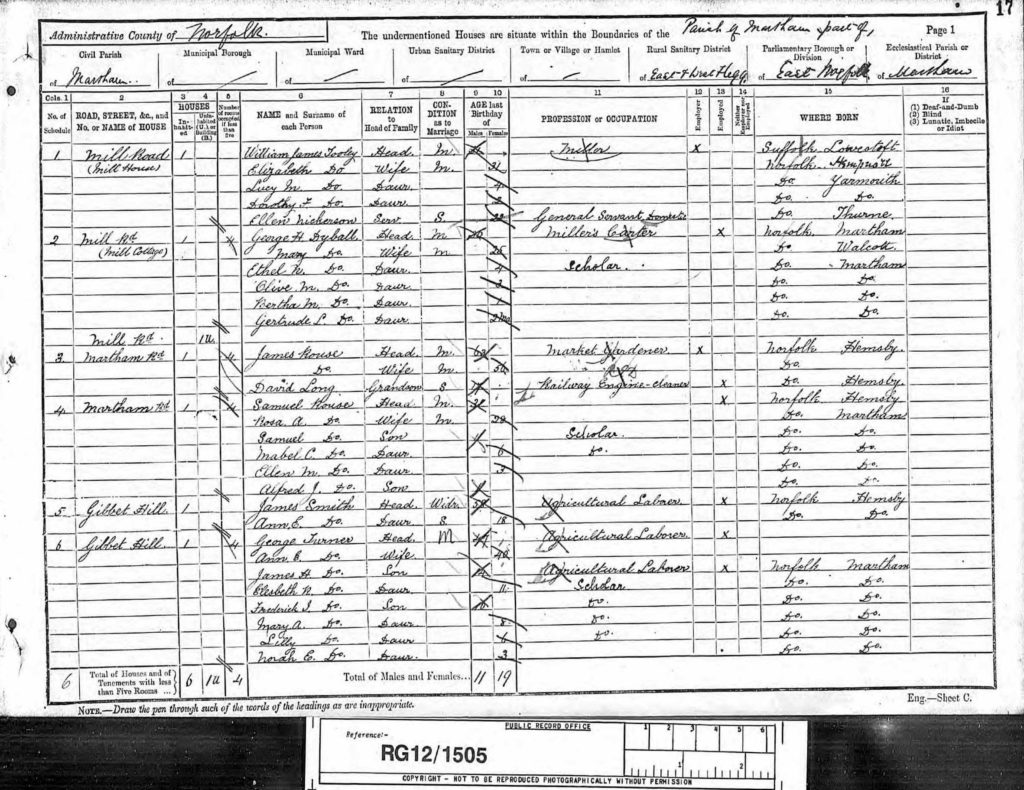
Evidently William Tooley wanted to sell the windmill in October 1892 when the following advert appeared in local newspapers:
MARTHAM
Sale of effects of Mr. J. W. Tooley, leaving village, upon the premises Martham Mill.
Six valuable houses etc. Yarmouth Independent – 30th October 1892.
However, William did not leave or perhaps did not sell the mill because the next advert shows he was still there in 1896 and he appeared in Kelly’s directory as the miller in the same year. He had, however, moved to Great Yarmouth by the time of the 1901 census.
On Wednesday next. To Millers
A Good Living for an Industrious Man, MARTHAM, Norfolk
Messrs. Spelman to Sell by Auction on June 3, 1896 at the Star Hotel, Great Yarmouth, the well situated and old established CORN WIND MILL doing its work up to settlement of purchase, with Dwelling house, cottage and garden, situate at Martham, in occupation of Mr. J. H. Tooley at £45 per annum.
Sold with immediate possession.
Apply to Messrs. Burton & Son, Solrs. Great Yarmouth.
Yarmouth Independent – 30th May 1896
1900 – 1911
At the beginning of the new century the mill was in the hands of Robert George Turner & Sons. Robert – known as George – and his family had long been associated with the mill at East Ruston. None of this branch of the Turners lived at Martham. Kelly’s Directory of 1900 listed Robert George Turner & Son as millers at Martham and they seem to have put it up for sale or rent according to this advert:
MARTHAM
To be Sold or Let. The Mill, Mill House, Cottage and Premises.
Apply Burton & Son, Solicitors, Great Yarmouth.
Yarmouth Independent – 6th January 1900
The 1901 census showed that local man Mark Nichols lived with his wife and children at the Windmill House. He was a journeyman and corn miller but was working there rather than being the owner because in 1904 Kelly’s Directory again listed Robert George Turner & Son, as being the millers. This map of 1905 shows the tower mill and surrounding outbuildings.
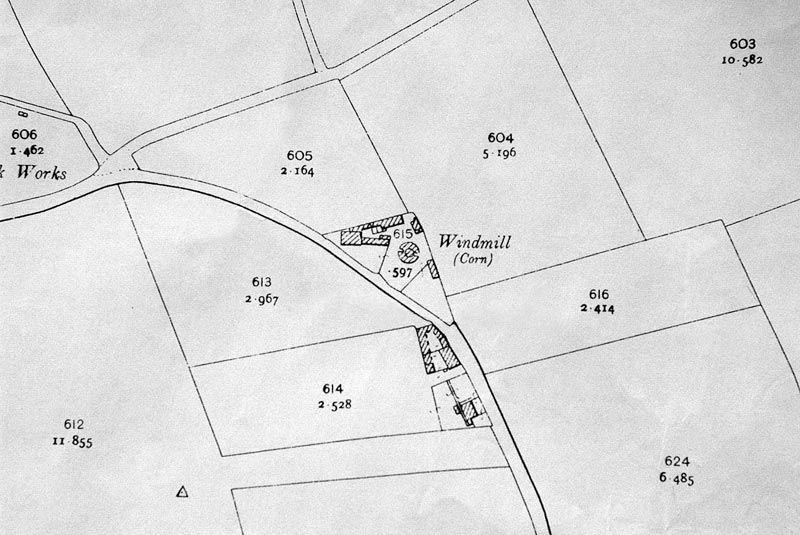
The mill was sold to Sidney Stackwood but was let to Christopher Austin Ingram from Earls Barton, Northants. Christopher was listed as the miller in a business directory of 1908 and as a miller and corn merchant in the 1911 census living at The Mill with his wife Sarah. However he does not show in any further records so he was only there for a relatively short time. Sidney Stackwood meanwhile was listed in the 1912 publication of Kelly’s as the miller of the wind and steam mill in Martham. Trade must have been difficult because he went bankrupt in August the same year.
MARTHAM MILLER’S BANKRUPTCY
The first meeting of the creditors of Sidney Stackwood, miller of Martham and lately of Bacton Wood Mill (miller there in 1908) was held on Saturday at the Norwich offices of the Official Receiver (Mr. H. V. Gould).
The debtor returned his liabilities at £1029. 6s. 9d. of which £325. 14s. 9d are expected to rank for dividend, there being one partly secured creditor for £430. The debtor put his assets at £133. 8s. 9d. leaving a deficiency of £492. 6s. The causes of failure, as alleged by the debtor are ‘Bad debts and expenses of removal to Martham and repairs to house and mill.’
The receiving order was made on the debtor’s own petition.
Dereham & Fakenham Times – 17th August 1912
In 1912, Samuel Carter a gamekeeper at East Ruston rented the tower windmill and steam mill which included an oat crusher, gears, fixtures and appurtenances at a yearly rent of £20 having responded to an advert for someone to use the premises as a miller. He was not there long because the mill stopped operating the following year and was demolished in 1914.
The tower mill had existed for well over a hundred years but during its last 20 years it changed hands or was rented by several different millers. People may think of millers as being dishonest or guilty of sharp practice but perhaps forget that a mill required enormous capital cost and expensive running costs for maintenance and repairs etc, It needed a hard working, skilled, strong businessman to successfully run a mill and the Martham mill had some who were successful for many years. In the end the changes of owner/occupiers may have been due to the cost of maintenance of the aging mill or a change of economics and demand of the times. By 1914 when it was demolished the country was facing war. Strong, young men, to run or be employed, had been sent to war and the time for the mill was up.
The Mill House still exists and Kathleen Jukes recalls how her grand mother, Alice Dyble (nee Simms), lived there until her death, aged 92 in 1968. At that time the house did not have running water and she got her ‘soft’ water from a well in her next-door neighbour’s garden and ‘hard’ water from a pump in their back yard. The mill had steam power and yet even in 1968 the mill house did not have electricity as Alice refused it because she didn’t trust it and used candles to light her way.
Appendix
The Final Will of James Bane (1768-1834). Dated 13th February 1834.
“I James Bane of Martham in the county of Norfolk. Farmer being of sound mind and disposing mind, memory and understanding do make, publish and declare my last Will and Testament in the manner following that is to say I give and devise unto Elizabeth my daughter all and singular my messuages, farms, dwelling houses, cottages, , barns, stables, mills, edifices, buildings, lands, tenements and hereditaments and real estate whatsoever both freehold and copyhold or wherever or where to I now have or claim any estate right, title or interest in possession, reversion, remainder contingency expectancy or otherwise howsoever situate lying and being in Martham and West Somerton in the County of Norfolk or elsewhere within the Kingdom of Great Britain with all the rights (members?) and appurtenances there into belonging . To hold the same unto my said daughter, her heirs and assigns forever. Also I give and bequest the use of and not the absolute property of or in all my household furniture and implements of household plate, lining, china books, pictures and prints, money and securities OCR money dead and live farming stock produce crops implements of husbandry and all the rest and residue of my good chattels and personal estate and effects whatsoever and of what nature or kind solver the same may be or consist except a legacy of ten pounds which thereby I give to Benjamin Bowgen my Executor hereafter named for his care and the trouble in the execution hereof unto Ester my wife for her life and from and after her deceased I give and bequeath the said furniture, money and securities for money, stock, crops, personal Estate and Effects and the absolute property of or in the same unto my said daughter to and for her own sole and absolute use, benefit and disposal provided nevertheless and notwithstanding anything herein before contained I charge my Mill and the piece of land on which it stands and their appurtenances in Martham aforesaid and now in the occupation of William Harrison Wells with the payment unto my said wife for her life of the annual sum of twenty five ponds in half yearly portions. And I give her the usual powers of entry and distress on the said Mill and piece of land in case of non payment of the said annuity for the recovery of the same together with all costs attending the same. And it is my will that in consideration of the provision I have herein made for my wife she shall release all her dower Estate and interest of and in all and every said hereditaments and real Estate whenever required and I nominate and appoint my said daughter and Benjamin Bowgen of Martham aforesaid farmer to be the Executrix and Executor of this my Will lastly hereby revoking all Wills and Testaments by me here before made I do declare this only to be my last Will and testament. In witness whereof I have herewith set my hand and seal the thirteenth day of February in the year of our Lord One thousand eight hundred and thirty-four
James Bane (seal)
Signed sealed published and declared by the above named testator as and for his last Will and Testament in the presents of us who in his presence at his request and in the presence of each other have subscribed our names as witnesses William Copper, Mary Forder, Chas Bell.
This Will proved at Rollesby on the twenty seventh day of March 1834 before the Reverend Thomas Baker, Clerk surrogate duly appointed to the Worshipful William Gonge, Clerk.”